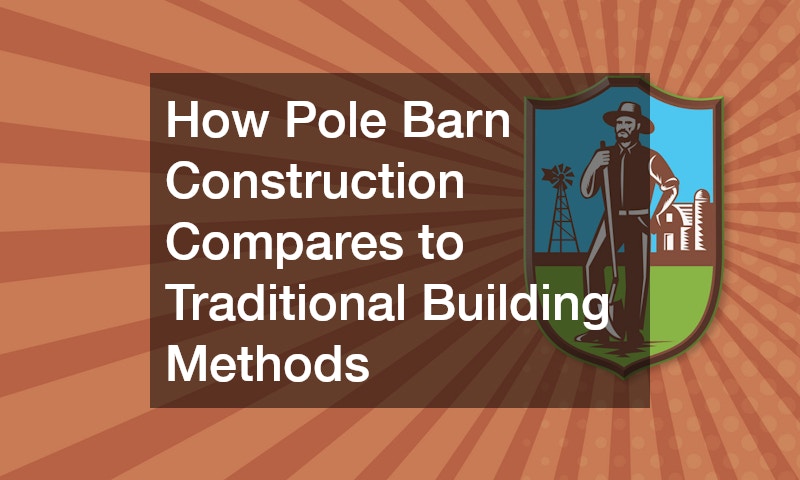When it comes to building a new structure—whether for agricultural, residential, or commercial use—choosing the right construction method is one of the most important decisions you’ll make. Pole barn construction, also known as post-frame construction, has gained popularity as an efficient and affordable alternative to traditional stick-built or masonry buildings. This article explores the key differences between pole barn construction and traditional building methods, examining their respective advantages, disadvantages, costs, and ideal applications. By understanding what sets these approaches apart, you can make a more informed decision about which one best fits your project needs.
What Are the Key Differences Between Pole Barns and Traditional Structures?
The main distinction between pole barn construction and traditional building methods lies in the structural framework. In traditional buildings, the framework is typically built on a continuous foundation—usually a poured concrete footing or basement—where load-bearing walls and beams distribute the building’s weight. Pole barn construction, on the other hand, uses large, pressure-treated posts (or “poles”) set directly into the ground or mounted on concrete piers. These posts serve as the primary support system, eliminating the need for continuous foundations.
This design difference significantly impacts both construction time and cost. Pole barns require fewer materials and less excavation work, making them quicker and less expensive to erect. Traditional construction, while more labor-intensive, allows for greater architectural complexity and customization, especially for multi-story or heavily finished structures.
What Are the Advantages of Using Pole Barn Construction?
Pole barn construction offers a wide range of advantages that have made it increasingly popular among builders and property owners. The first and most obvious benefit is cost efficiency. Because pole barns use fewer materials and require less labor to assemble, they can often be built at a fraction of the cost of traditional structures. The reduced need for a continuous concrete foundation alone can save thousands of dollars.
Speed is another major advantage. A typical pole barn can be completed in a matter of weeks rather than months. The simplicity of the post-frame design allows for rapid assembly, making it an excellent choice for projects that need to be operational quickly, such as farm buildings or commercial storage units.
Versatility is also a defining feature of pole barn construction. These structures can serve a wide variety of purposes, from agricultural barns and garages to workshops, retail spaces, and even custom homes. Modern pole barn designs have evolved well beyond their rural roots, incorporating insulation, siding, windows, and interior finishes that make them suitable for residential use.
Durability plays a role as well. When properly engineered, pole barns can withstand heavy snow loads and high winds thanks to their flexible yet sturdy post-frame design. The treated posts are resistant to rot and pests, giving them longevity even in challenging environments.
What Are the Disadvantages of Pole Barn Construction?
Despite their benefits, pole barns do have some drawbacks that potential owners should consider. One of the most common concerns is aesthetics. Traditional homes and commercial buildings often have more refined exterior appearances, whereas pole barns tend to have a simpler, more utilitarian look. While this can be addressed with siding, roofing, and trim upgrades, doing so may increase costs and offset some of the initial savings.
Zoning and permitting restrictions can also be a challenge. Some municipalities impose regulations on post-frame construction, particularly in residential areas where they may be viewed as agricultural or temporary structures. Before beginning a project, it’s important to confirm local building codes and obtain the necessary permits to avoid complications.
How Do Costs of Pole Barns Compare to Traditional Buildings?
One of the strongest arguments in favor of pole barn construction is cost savings. The difference starts with the foundation—pole barns don’t require the same continuous concrete base that traditional structures do. Instead, posts are set directly into the ground or onto concrete footings, significantly reducing excavation and material costs.
Long-term maintenance costs are another factor to consider. Pole barns often require less upkeep, particularly if metal siding and roofing are used. Traditional structures, while more customizable, may need more frequent painting, sealing, or siding repairs over the years.
What Types of Projects Are Best Suited for Pole Barn Construction?
Pole barn construction is ideal for projects that benefit from open floor plans, quick build times, and cost efficiency. Agricultural buildings are the most common example—barns, stables, and equipment storage structures often use pole barn methods due to their spacious interiors and durability.
Workshops and garages are another popular use. The post-frame design provides ample room for vehicles, tools, and machinery without interior obstructions. For business owners, pole barns make excellent warehouses or retail showrooms thanks to their adaptable layouts and affordability.
In recent years, pole barn homes—often called “barndominiums”—have become increasingly popular. These structures combine the practicality of a pole barn with the comfort of a modern home, offering open-concept living spaces, high ceilings, and rustic charm. They are particularly appealing to homeowners seeking cost-effective alternatives to conventional housing.
Ultimately, the choice between pole barn construction and traditional methods depends on your specific goals, budget, and long-term plans. For those seeking efficiency and value without sacrificing durability, pole barn construction offers a compelling solution that continues to reshape the way people build today.
